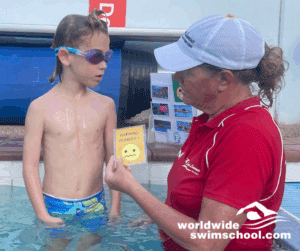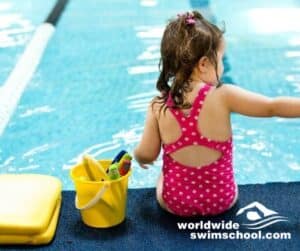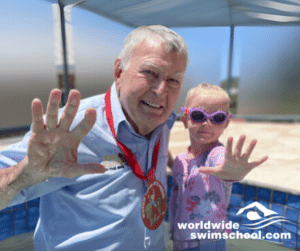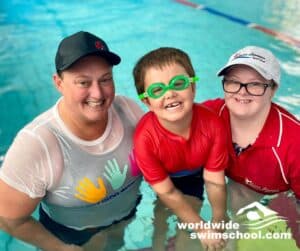Swimming is a building block process. Therefore, it’s important that swim teachers and coaches progress slowly with skills and swim styles. Once each skill is learned and mastered, then it’s time to move on to new activities.
In addition, it is imperative that skills are conquered before moving on. For instance, if any steps are rushed or missed in the learn to swim process, then the eventual stroke and swimming technique may suffer. Here, we will discuss and break down skills in the learn to swim process.
The 6 Stages of Swim Styles
The skill building process as discussed in this article can be broken down into six stages. Swim schools may have different stages within their program. However, the most important thing is that swim teachers take their time in each of the phases of learn to swim As a result, this will ensure confident swimmers are ready to progress and continuously improve within the program.
The following stages are a guide that World Wide Swim School uses in teaching their swimming curriculum. These building blocks for swimming lessons are focused on in each and every aspect of the program. For example, from infants all the way up to stroke development and squad. In addition, specific skills and drills can be given to swimmers to improve each of these stages of swimming.
The 6 stages of swim styles are:
- Breath control
- Submersion
- Floating
- Propulsion (arms and legs)
- Breathing
- Safety Skills
Investing time into your employees will help keep them current on what is expected of them. But also, to ensure that safety and compliance remain at the top of the priority list.
Step 1: Breath control
Breath control is the process of taking a big breath in, closing the mouth and nose off and holding the breath in. In addition ,this swim style can be improved by holding the breath for 1, 2 or 3 seconds in the initial stages all the way up to 10 seconds.
Good swim teachers will demonstrate breath holding for short periods of time with cheeks full of air. For example, a good way to explain this is by saying, “Look at my balloon face. Now you show me a balloon face.” This activity of breath control will produce the following results:
- Water does not enter the nose or mouth, and ensures comfort
- Deep breathing activities will raise the level of cardiovascular fitness
- Filling the lungs with air will help swimmers remain on top of the water
- Eyes can be placed in the water in the lead up to the next skill

Step 2: Submersion
Submersion is a swim style where part or all of the body is submersed under water. Therefore, the aim of submersion is to get the swimmer under or moving through the water. Putting eyes in the water or going under the water can be an assault on all of the senses. The changes include:
- Sight: changes as the eyes go under (with or without goggles)
- Hearing: changes as noises are muffled or blocked out
- Smell: of the water is a different sensation
- Taste: may be affected if a little bit of water gets in their mouth
- Touch: is different in the water as the swimmer will move slower
Any part of the body can be used in submersion activities. For example, shoulders under, ears in the water and face under water are all a great start when introducing submersion activities into a lesson.
Step 3: Floating
It’s important to note that during the floating process, the main aim is to relax and feel comfortable in the water. For example, it must be done without kicking the legs or moving the arms. Therefore, swimmers need to feel their own buoyancy in the water and learn to let the water work for them. For example, not fight against the water. Swimmers should practice floating on both their front and their back. There are certain things to remember when teaching beginner swimmers the skill of floating, such as:
- Use a kickboard during initial stages of floating
- Start with hopping or jumping activities in working towards floating
- Teach swimmers how to stand up from a floating position
- Learn to push and move through the water and stand up to recover
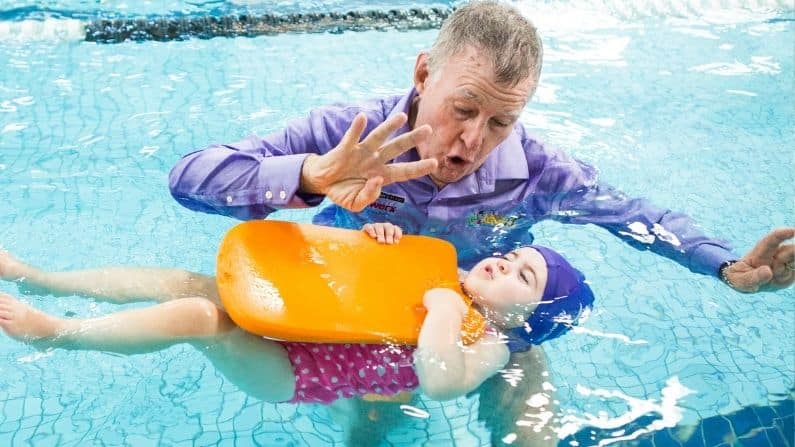
Step 4: Propulsion
There are two different types of propulsive skills in the water – arm movements and leg movements. Tis swim style should be broken down into separate learning opportunities for swimmers and practiced regularly. Manipulation is suggested during the propulsion stage of learning to swim. In addition, a high level of muscle memory is created.
Arm propulsion - a step-by-step building block process will come into play when teaching all 4 competitive strokes and the rescue strokes. Instructors will need to understand their swimmers needs and abilities to know which propulsive activities to teach at what time.
Leg propulsion - manipulation is key in teaching leg propulsion. When introducing a new propulsive skill for the legs, instructors should take the time for repetition. If swimmers are given an opportunity to hone their skills effectively at an early stage they will excel in their swimming.
Step 5: Breathing
Breathing is different for many of the different strokes. There are different breathing types (side/front) and techniques (single side/bilateral).
Like any skill in the swimming process, breathing should be broken down and taught slowly and efficiently. Swimmers will need to learn both exhaling and inhaling within their lesson. There are many types of breathing drills and skills that can be taught within the lesson. Refer to your swim school for ways to teach specific breathing skills.
Remember that the body position may change in the water when breathing is introduced. So, as with all skills, it may be desirable to practice less difficult skills when initiating breathing activities in the lesson.
Step 6: Safety Skills
Safety skills are an important part of swimming lessons and should be practiced sporadically throughout the learning process. Important safety skills can be planned for swimmers of all ages and abilities.
There should be multiple safety skills that can be practiced in each and every swimming stage discussed in this article. Some examples of these are: entries, exits, calling for help, turns to a safe spot in the pool, rollover breathing for recovery, reach rescue and tow rescue.
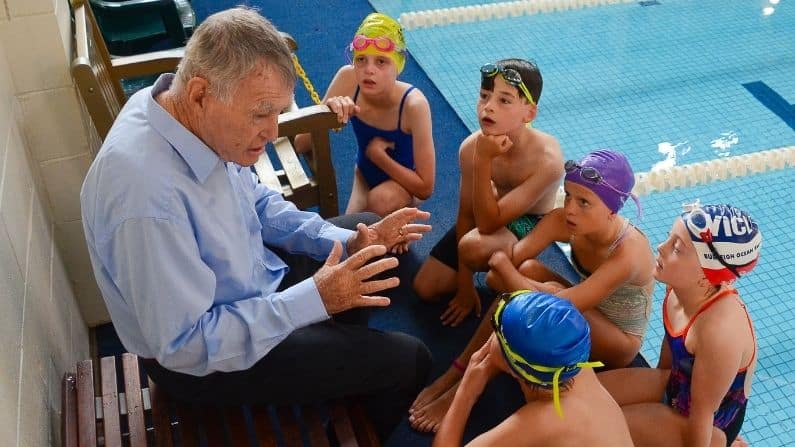
Conclusion
Age isn’t a factor in learn to swim and prior experience can limit or enhance individual needs. A four-year-old may be at the same learning stage as a twelve-year-old. Good instructors will factor in the above swimming skills discussed. In addition, they will plan activities that are skill building to ensure swimmers are constantly learning, improving and have opportunities to excel in their swimming.
Remember to ensure activities are achievable and exciting while building upon skills that have previously been mastered. Remember – skill building can help instructors plan and deliver lessons to many age groups and abilities within a single lesson or an entire swim school.
Swim Schools get your staff upskilled today with the Swim School Hub.
Join the World Wide Swim School Community today to receive latest offers, news free to your inbox.


